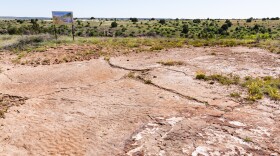The Osage Nation took a big step in its preservation efforts to restore a sacred site in St. Louis, about a ten-minute drive from the Gateway Arch. The tribal nation said it now owns the entire Sugarloaf Mound, built more than 800 years ago when hundreds of mounds were in the area called "Mound City."
Despite the significant progress toward safeguarding the Osage Nation's ancestral homelands, the tribe's historic preservation director, Andrea Hunter, said those efforts are far from over.
"We have a significant amount of work ahead of us to remove all the structures from the properties and stabilize the mound," Hunter said in a statement. "Now more than ever, our office is dedicated to preserving this sacred site while also educating people about our rich history in the St. Louis area."
The tribal nation has plans to build an interpretative center and is actively seeking funding to further preservation plans.
Archeologists identified Sugarloaf Mound as a Woodland Period burial mound or a Mississippian platform mound, noting it was built between the years of 600 and 1200 AD.
"When the French began construction of what would become St. Louis in 1764, the future city contained possibly hundreds of mounds," a report co-authored by Hunter said. "While many were relatively small burial mounds situated on the bluffs overlooking navigable waterways, there was also a major Mississippian civic-ceremonial complex located just north of the Gateway Arch."
Now, many centuries later, after the area was leveled for residences, beergardens and other uses, the Sugarloaf Mound is the only standing mound in the area. It's about a twenty-minute drive from the Cahokia Mounds, which is the largest pre-Columbian site north of Mexico and is located on the other side of the Mississippi River.
"The tremendous amount of the Osage Tribe's history that has been lost due to the demolition of ancestral homes, villages, and, most significantly, the mounds in the St. Louis area other than Sugarloaf is devastating," the report said. "Hundreds of years were erased from the landscape. Moreover, from an Osage perspective, the mounds are sacred. …The Osage, therefore, consider it an honor to protect the last mound of their ancestors in St. Louis for all of the tribes that are heirs of the Mississippian culture."
Hunter said it was a 17-year journey to get the Sugarloaf Mound under Osage Nation control. Under the leadership of then-Osage Nation Principal Chief Jim Gray, the tribe purchased about one-third of the site for $235,000 in 2009.
She also credits the arts and culture non-profit, CounterPublic, for their support in the reacquisition, including their help with negotiations and the sale and transfer of the land.
This report was produced by the Oklahoma Public Media Exchange, a collaboration of public media organizations. Help support collaborative journalism by donating at the link at the top of this webpage.








